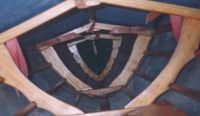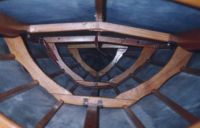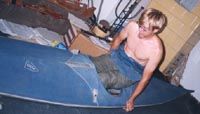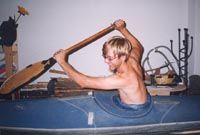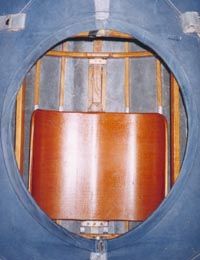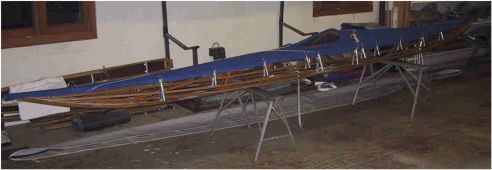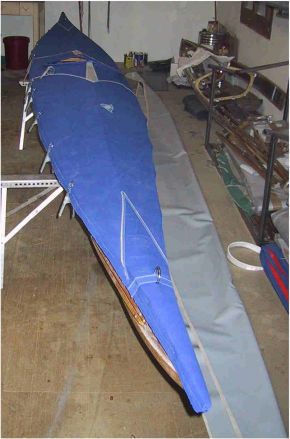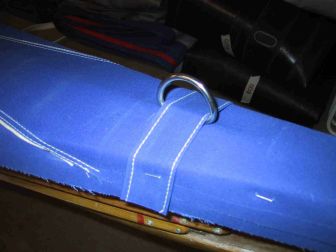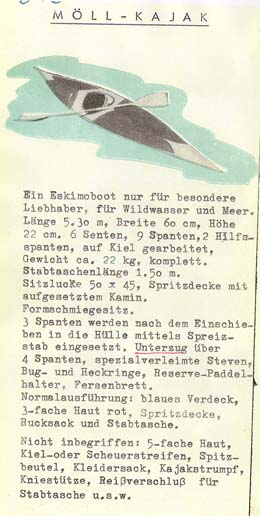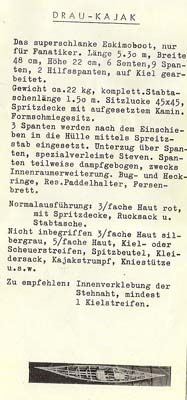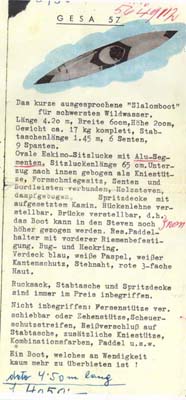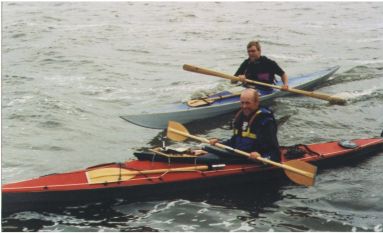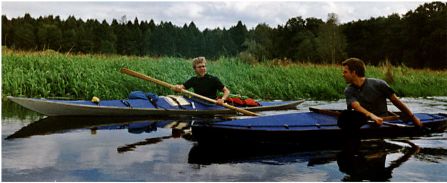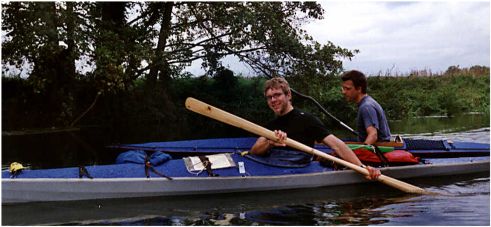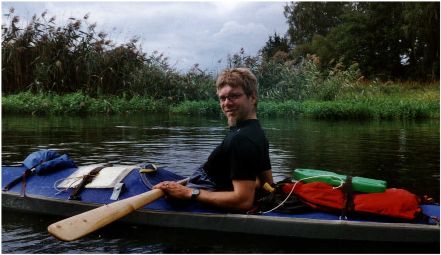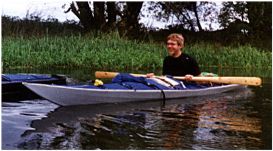[in German]
The
Story of my  Moell Kayak
Moell Kayak
![]() The
Discovery
The
Discovery
It all began,
while I was trawling through cyberspace in the dark of the night, it was
a Monday. I had just started to check the online edition of a Berlin advertising
paper for bargains and had reached the "second hand" department.
From the "canoes" section the words "Single Kayak, original Moell" jumped
at me. Moell? Was that not one of those old folding Greenland type boats
designed and used for white water? Was this not the boat, whose lines
I had admired so much in "Der Hadernkahn" ["The Rag Boat", a pictorial
history of the folding boats of the first half of the 20th century by
Christian Altenhofer]? Had I not seen one of these graceful boats during
the last international folding boat rally in the town of Schwarz [Germany]?
Yes, it was the very same boat! "Der Hadernkahn" contains a set of lines
drawings of this boat, showing off its elegant curves, as well as clarifying
a number of design features it has in common with Greenland type kayaks.
Furthermore, there were a number of photos showing boats, which were remarkably
similar to the Moell.
I napped
briefly, cut the night short and then ran down to the newsstand as soon
as it opened to buy the print edition of the ad paper, which contains
the telephone numbers. D…! An answering machine! Left message (which contained
phrases like "whatever happens", "under any circumstances", must have"
…), called back every hour.
The day dragged on, but finally the evening came: Contact! Thomas told
me that I was the first caller, described the condition of the skin as
"very old, porous, but usable" and asked for DM 800. I enquired whether
it was a Greenland boat and he said no (this response turned out to have
been based on a misunderstanding). But he did go on to say that it was
a very narrow, fast boat, the prettiest he had ever paddled. Good, I would
look at it in any case. We agreed on a time to meet, but at the last minute
Thomas had to cancel. It was a whole week later that we finally got together
and I could look at the boat!!
Meanwhile I had started my background investigations. I posted to the forum on www.faltboot.de, asking whether anyone knew anything about the Moell ("built in southern Germany in the 1950s in very limited numbers, apparently not a Greenland boat"). Dirk Bredow answered, but he certainly only knew of Moells in the context of Greenland boats. Even Markus Heise could shed no further light on the matter. Finally Andreas lent me a book by Lorenz Mayr, "Eskimo Kayaks on Alpine Rivers - A Handbook for Amateur Folding Kayak Builders", which contained a lot of information on the development of the Moell kayak.
![]() The
Boat
The
Boat
I was numb with anticipation as Thomas and I drove into the eastern part of Berlin, where he had stored the boat. As soon as I saw the skin spread out on the ground a huge weight was lifted off my shoulders: IT WAS A GREENLAND BOAT! Long, very narrow bow and stern sections, blue deck (including the GESA logo [the famous old company that had built these fine boats]) and a silvery, shiny hull, which was stiff and obviously porous. Then we laid out the parts of the frame: Narrow, long pieces, some of them tiny and many, many small details. This was in complete contrast to what I was used to in boats by Pouch, Klepper and Feathercraft, only the construction of the Pouch Greenland folding boat ("Falt-Eski") might be comparable.
We assembled the frame so that I would have a good introduction to its tricks and secrets. What a feast for the eyes! Very long, narrow, graceful lines, some very cleverly executed connections between the various parts, some elegantly simple and then the completed boat lay before me on the lawn. Only one small piece of wood had been broken, other than that the frame was in excellent condition.
The skin on the other hand was in sorry shape. The canvas deck, with its doublers around the cockpit, as well as at bow and stern, was in relatively good repair, but the rubber hull material had definitely started to knock at death's door. It had hardened in several places, had broken where it had been folded and was probably porous over large stretches. In short, the skin would never be more than a relic for a museum display. Due to the condition of the skin, Thomas agreed to drop the price to DM 700, a sum, which Rainer lent to me with his usual largesse (I was about to undertake an internship in the UK and my bank account had just reached new depths in red).
![]() Trial!
Trial!
And then I finally got home with my treasure. It was much easier to carry than my old KTW-Pouch E65 [single]. Also the longitudinal frame members were much shorter at only 1.50 m [about 59 inch]. I was sure that I would be able to stow it in only one long bag to take on future trips …
Of course I could not keep my excitement to myself and had to write a veritable flood of emails, as well as posting to the forum on www.faltboot.de about the treasure I had just recovered. Next I assembled the boat in its skin for the first time. It turned out to be more difficult than I had thought and I forgot to include the stabilizing carlings. Nonetheless, on the whole the assembly procedure is straightforward. The hull-to-deck seam is a positive feature in this respect ["eingesäumte Stehnaht" = hemmed stand-up seam]: The bow and stern can be inserted easily without any tendency to crumple the seam, which in turn obviates the tiresome need of moving the frame back and forth a lot within the skin to wriggle it into the proper position. The frame and skin fit perfectly!
|
|
Stern, seen from the cockpit |
Of course I had to take some snap shots of the boat on dry land, so that I could demonstrate to my girl-friend Meggie during the following weekend in Rostock what all the excitement was about.
Checked the cockpit for fit! Pretty tight, especially entering and exiting the boat turned out to be tricky (despite my narrow hips :-).
|
|
|
Once I was seated I enjoyed perfect contact with the boat. The carlings on either side of the seat and the fact that the latter is deeply dished really makes for a secure fit.
One week later, I was almost on my way out of the door to the UK, I got one last opportunity to take my darling out onto the water together with Jens on Lake Tegel. Transportation by "S-Bahn" [tram line] presented no problems at all. Assembling the boat progressed rapidly (and I enjoyed Jens' admiration of the boat :-)). As soon as the boat touched the water it was clear that the hull really was not tight any more, but it would last at least ten minutes. The Moell tracked beautifully, but was nimble in the turn once edged onto its gunwale. It was quick to accelerate and had excellent glide. I tested rolling characteristics while holding on to Jens' bow and got a little worried: Initially I slipped out of the seat far too easily (did I mention the narrow hips?). Also the spray skirt was very tight and lacked the ripcord (safety standards of the 1960s, tsk, tsk!). In case of a wet exit this would have given me problems.
We emptied
the boat quickly to allow Jens to take a spin in it. Of course he was
as excited as I. Now that I could see the Moell in action from the outside,
my enthusiasm grew further still. The boat exuded an unbelievable aesthetic
appeal as it glided along in the failing light. The bow and stern draw
upwards, but not too much, the hull is slender and fast.
Once we got back we did a quick test with the garden hose and water inside
the boat, but unfortunately we could not find a single sizeable hole to
blame for the leakage, which meant that the entire skin was just very
porous.
The next night was my farewell party. I had assembled the Moell so that everyone could get one last good look. All winter the boat waited with longing for a skilled tailor or saddler, who could build a new skin for the it, as close to the original as possible..
![]() At
last! The new skin arrives!
At
last! The new skin arrives!
At the beginning of the summer I sent the boat to Markus Heise, who had promised to build me that new hull and deck. We discussed the choice of materials (grey Hypalon, blue canvas) and the details (type of hull-to-deck seam, D-ring placement, small alterations to the frame etc.) on the phone.
My anticipation grew and grew. At last, first pictures of the skin:
Two days later Markus sent the first pictures of the deck:
The boat arrived via "lighting mail" with its new skin just in time for me to take it to the folding kayak rally in Darss and to try it there on the water …
Now I have high hopes of being able to show my Moell the lakes of Mecklenburg, the Baltic, the North Sea and so much more while it is still summer - because now I no longer have to spend time trawling cyberspace for bargains.
![]() Catalogues
Catalogues
The original Gesa-Catalogues are rather information leaflets, showing the very small amount of boats that had been produced by Gesa (rumours suspect about 20 Moell kayaks produced at all) . The catalogues have been copied by Markus Heise (thanks for that, Markus!).
I'll soon come up with an English translation of the leaflets.
![]() The
first trips
The
first trips
A wet daytrip Tagestour on the Darss (at 3 to 5 Beaufort and short, steep waves):
Some pictures on how not to roll ...
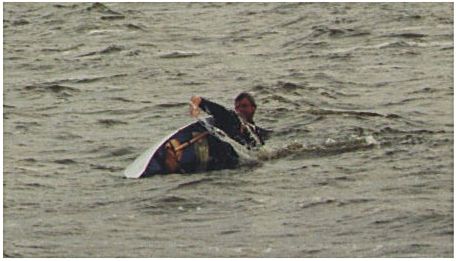
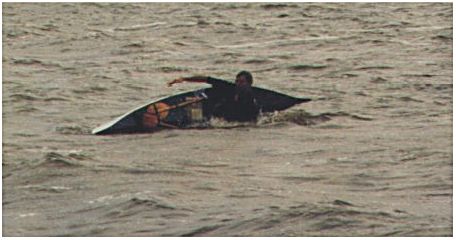
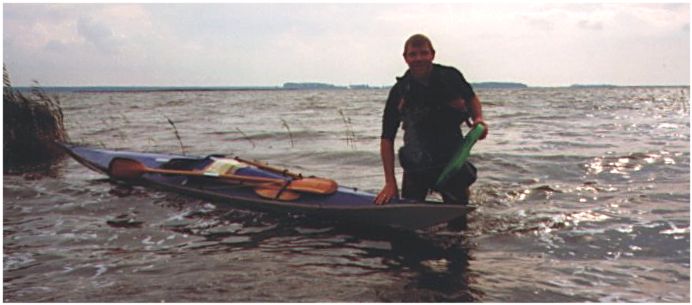
River Mueggelspree (just outside of Berlin) together with Rainer und Andreas:
Want even more pictures? See two greenlandic folding kayaks on the river Schwentine.
If the
above has whetted your appetite to paddle your own Moell, I have good
and bad news for you.
First the bad news:
There were never many Moell kayaks in the first place. Many have disappeared.
The current stewards of those boats that have survived will treasure them
and you are unlikely to get a shot at tearing the boats out of their determined
grasp.
Now for the good news:
Ralph Hoehn (www.PouchBoats.com)
is in the process of translating and updating the book by Lorenz Mayr,
which I touched upon at the beginning of this account. This book contains
complete and very clear instructions on how to build your own folding
boat, as well as providing a good number of designs to build or to adapt
to your own dimensions.
I am the webmaster for www.PouchBoats.com and am proud to announce that
we have set up a discussion forum and an
email list server dedicated to amateur folding boat builders on this
website. We hope that this will provide a place to meet, to exchange ideas
and to drive further forward the art of building folding boats to the
large number of amateur builders, who are scattered about the globe.
